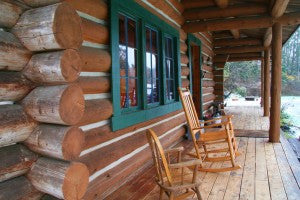Log Home Staining Preparation - What To Do

Getting your log home prepped prior to staining is a big deal but that doesn’t mean the preparation will necessarily be difficult! Carefully scrutinizing your log’s exterior walls is crucial; and using professional products recommended by builders or industry professionals is more important than most realize. For those who choose to select short-cuts and lower-end maintenance products are only cheapening a home that was, presumably, a huge investment—both emotionally and financially.
A single stain will not be universally compatible for every log home—the species of wood, the stain’s breathability and flexibility as well as the log home’s surrounding environment need to be taken into consideration when picking out the best, most appropriate stain. The best stain choice will produce satisfaction and admiration while an inappropriate stain can lead to chaos and regret.
Before any staining project begins, there are certain things you must do to ensure your log home is completely ready for its stain application.
Log Home Staining Preparation
Take A Tour!
Yes, take a tour of your home on the outside and look for as many potential problems as possible that may (or may not) exist. First things first; and that means checking every detail, possible. Be on the look-out for:
Checks, Gaps & Cracks
Make sure any areas where air, water and insects can invade are properly attended to. Re-chink or re-caulk if necessary. Even the smallest of cracks and/or microscopic separations should be covered with new material and feathered with a stainless steel trowel. If any chinking has come loose, chances are good it happened due to mill glaze, dirt, oil or other contaminants that weren’t removed, resulting in improper adhesion.
Water Stains
If you notice water marks on your logs, a good-quality wood cleaner will remove them. The bigger issue, however, is figuring out what is causing the water leakage in order to prevent any bigger issues.
Faded Areas
You can expect the top sections of your logs to be more faded than the bottom sections due to increased exposure to sunlight. This doesn’t, necessarily, mean the logs are damaged nor does it necessarily mean the logs have lost their water repellency. With that being said, however, you should still check for water proofing by splashing water on any questionable areas. If the water runs off, you’re good. If the water even remotely soaks into the wood, put on another application of a protective clear coat after staining.
Contaminants
Dirt, oils, mildew, spider webs, pollen etc. should all be removed with a mild log cleaner. A simple hosing of your log home at least twice a year will keep you logs much more receptive for any staining. Some log home owners prefer to use corn-blasting or a pressure washer--adjusted to a low setting at 500-1000 PSI--to prevent any possible damage to the logs’ surface. After 3-5 days of air-drying, the logs should be ready for staining. Your original finish may have to be removed; and a quick trick is to apply masking tape on the dried surface. If any remnants of finish stick to the removed piece of tape, invest in a high-quality chemical stripper to ready the wood for the new stain.
Wood Issues
Any spongy, rotted wood needs to be completely removed before staining; and empty spots can be treated with liquid epoxy and wood filler. It’s rare that logs have to be completely replaced. If you have a log home that has been neglected and some of the logs look questionable, it never hurts to consult with a professional to see if suspicious-looking logs are salvageable.
Also, little burrowed holes in your logs with tell-tale piles of accompanying sawdust indicate carpenter ants or beetles. The structural integrity of any given log would be dependent on the number of holes and how pervasive they are throughout the log wall or walls. If the number of holes are few, an application of borate treatments will curtail the problem; but again, if the burrowing is extensive, calling upon a professional would be advised.
Choosing the right stain is one of the most important decisions you will make concerning your log home; and preparing your home’s exterior prior to staining is equally important. By following manufacturer’s instructions carefully and using nothing less than high-quality products, your log home will continue to be a source of pleasure and gratification for generations to come!
